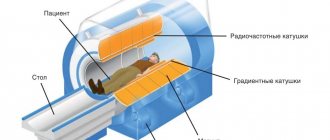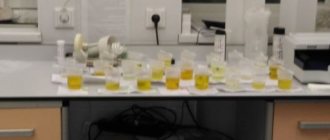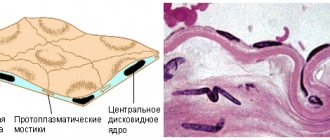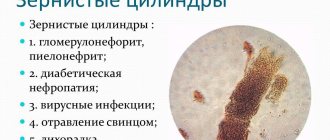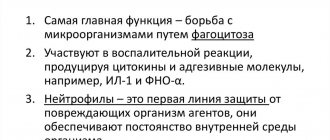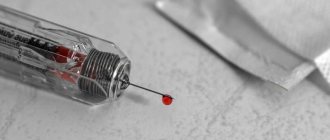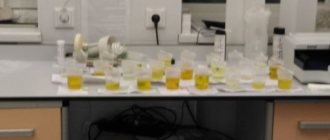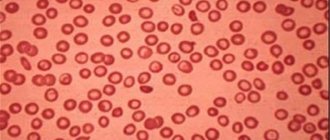Author of the article
Anatoly Shishigin
Reading time: 4 minutes
AA
A chemical study of the composition of urine can identify elements that are retained in the body for its vital functions, as well as waste substances that it gets rid of. The removal of various enzymes is not always the norm; in particular, with diseases of the genitourinary system, the filtration of incoming fluid fails and red blood cells, protein and glucose are removed from the body.
When chemical compounds break down in the urine, salt, oxalates, phosphates and urates are formed. The appearance of phosphates in test results requires careful identification of the cause. If the appearance of salts in the urine is not constant, then they can be associated with diet disorders and the removal of excess phosphorus from the body.
If the amount is exceeded several times, a repeat study is required to look for the causes of this pathology. Phosphorus-calcium metabolism is disrupted in many cases, which creates conditions for the proliferation of harmful microorganisms and the appearance of urolithiasis. Salts in the patient's urine detected in the patient's tests - what does this mean? First of all, this is a signal of the development of pathology.
The mechanism of appearance of phosphates in urine
Salts are formed as a result of an imbalance in the acid-base balance. During metabolism, phosphorus is converted into an acid, which subsequently combines with various elements to form phosphate salts. Typically, such formations are gradually eliminated through the kidneys and do not cause harm to the body.
With some diets and diseases, the acidity of urine changes. Under alkaline conditions, increased formation of amorphous phosphates and tripelphosphates is observed. The kidneys cannot cope with the load - they do not have time to remove all the salts, which is why they accumulate and form calculi (stones).
Phosphate salts, being in excess, interfere with the absorption of a large number of useful substances in the body, including calcium, which inevitably leads to hypocalcemia.
Problems occurring in children
If phosphaturia is determined in a child based on the results of a urine test, then he must be re-examined. You should first adhere to a diet and nutrition regimen. In young children, the condition has pathological or physiological causes. The latter include changes in diet, dislike of meat products, and the predominance of sweets. There is nothing dangerous about this.
The pathological cause of phosphaturia in children is rickets - a rather rare disease, but dangerous. If such a problem is detected, it is important to start treatment on time. It includes constant intake of vitamin D and sunbathing - a natural source of the missing micronutrient. If a child has additional symptoms of rickets, then he needs mandatory consultation with several specialists: a pediatrician, a neurologist and an orthopedist.
What tests detect phosphates?
Determining phosphates in urine is very simple. It is enough to pass a general urine test for salt. This is a simple and informative type of research.
Examination of the urine reveals unusual sediment, indicating problems with renal filtration. The fact that there are phosphates in the secretions is indicated by low acidity - less than 7.
To obtain detailed results about the functioning of the urinary system, a daily salt test is prescribed.
In order for the result to be as reliable as possible, a couple of days before submitting the material you must:
- eliminate physical and emotional stress;
- remove harmful foods from the diet (smoked meats, pickles, sweets);
- quit bad habits.
Other tests may be needed:
- bacteriological culture of urine;
- blood analysis;
- radiography;
- Ultrasound of the thyroid gland, bladder and kidneys.
Patient examination
To diagnose the problem, the doctor will prescribe a general urine test. It is important to properly prepare for it: the day before you should not take diuretics, and eat foods that color urine. If these salts are found in the sediment and the balance is shifted to the alkaline side, further research should be carried out on the daily amount of excretion of the element. To do this, all the liquid produced per day is collected in one container and delivered to a laboratory, for example, Invitro.
Next, a clinical blood test is done to check the phosphorus content in it. The doctor interprets the result using a special table. To identify crystals and uroliths in the kidneys, ultrasound and, if necessary, MRI are prescribed.
Reasons for the appearance of phosphate salts
There are several factors for phosphate getting into the urine in adults and children:
- incorrect lifestyle and diet (vegetarian menu, some diets);
- abuse of foods high in phosphorus (dairy products, seafood, whole grain cereals, mineral water);
- metabolic disease;
- lack of fat-soluble vitamins;
- pregnancy (changes in hormonal levels and taste preferences);
- dehydration due to vomiting and diarrhea;
- poisoning with chemicals containing phosphorus.
Amorphous phosphates in the urine of a child under 5 years of age usually indicate immaturity of the digestive system and mechanisms for regulating metabolic processes.
Phosphates and other salts in urine can be a sign of various diseases:
- genetic disorder - phosphate diabetes;
- Fanconi disease;
- urolithiasis (stones in different parts of the urinary system);
- chronic kidney failure;
- renal tubular acidosis or congenital anomaly;
- hyperfunction of the thyroid and parathyroid glands.
Often the amount of phosphates in the urine increases with inflammatory and infectious diseases of the genitourinary system:
- cystitis;
- pyelonephritis;
- urethritis;
- prostatitis.
Diagnosis of indicator levels
Phosphaturia is diagnosed using a general urine test. Normally, an adult should receive about 1200 mg of phosphates per day. About 800 mg should be excreted in the urine. In a urine test, the salt level is indicated by a “+” sign in the amount of 1-4. A + or ++ reading in the sample is normal. If there are more pluses, this indicates a violation of salt metabolism.
To obtain more reliable and detailed information about the presence of amorphous phosphates and the dynamics of their concentration, it is recommended to collect daily urine (Zimnitsky analysis).
Rules for collecting urine for analysis
To get reliable results, it is recommended:
- 7 days before the test, exclude from the diet foods that contribute to the alkalization of urine (smoked foods, sweets, alcohol).
- Buy special containers for collecting material from the pharmacy.
- If you need to do a general urine test, take a mid-morning urine sample on an empty stomach and deliver it to the laboratory within 2 hours.
- If you intend to collect daily urine, the first portion should be collected at 6 am and a new container should be filled every 3 hours.
- Before urinating, be sure to wash yourself without using soap so that foreign impurities do not get into the material.
- Store the collected urine in a cool, dark place (not in the refrigerator), the container is carefully sealed.
- On each container you need to indicate the time of the collected urine portion and the patient’s initials.
Additional symptoms of phosphaturia
Mild phosphaturia can go undetected for a long time, especially when its cause lies in diet and is temporary. But if the deviation is caused by one of the diseases, then specific signs will be added to the general signs, indicating a high level of phosphate salts in the urine.
The main symptom is cloudy urine with the formation of sediment and flakes. If you ignore the problem for a long time, other signs of the disease may appear:
- nausea and vomiting;
- aching pain in the lumbar area (especially after physical activity);
- flatulence;
- intestinal colic;
- false urge to defecate;
- frequent urination;
- incomplete emptying of the bladder;
- pain in the stomach, back, groin:
- low-grade fever (with chronic pyelonephritis).
Phosphaturia in pregnant women
In a woman who is in an interesting position, phosphate levels in the urine increase. The reason for this is a change in diet. Due to toxicosis in the early stages of pregnancy and a growing uterus in the later stages, the expectant mother gives preference to dairy foods, excluding meat products. To improve digestion before childbirth and avoid constipation, pregnant women prefer plant-based foods. This explains the change in the level of salts in the urine.
To monitor the condition of the body, pregnant women are regularly prescribed a urine test. If doctors see serious deviations from the norm, they prescribe a diet and a more detailed examination - ultrasound.
Attention! Treatment of phosphaturia during pregnancy is not always justified. In general, therapy becomes a prerequisite for the formation of oxalate stones, which are much more difficult to get rid of.
When is treatment needed?
The need for therapy is determined individually. Treatment methods directly depend on the reasons that caused the increase in phosphate salts in the urine. Initially, the patient is prescribed a full examination, including ultrasound of the urinary system.
In uncomplicated cases, the problem is solved using the following methods:
- taking medications;
- physiotherapy;
- dietary ration;
- additional multivitamin complex;
- kidney cleansing using diuretic herbs;
- exercise and exercise.
A person needs to watch what he eats. The menu should be varied and balanced. It is advisable to remove fatty meat, fish, milk and cottage cheese, chocolate, sweet fruits, beans, marinades, sauces, ketchup and spices from it.
Only a specialized doctor has the right to prescribe treatment. It is necessary to adhere to all recommendations regarding dosages and timing of therapy. Self-medication is dangerous and can lead to complications.
Pathophysiology
Phosphates are compounds formed by the reaction between alkaline solutions and phosphoric acid. These substances enter the human body along with food components and are necessary for life. The largest amount of the chemical contains teeth and bones - up to 85% of the total. In addition, it is present in the following tissues:
- brain;
- muscular.
In fact, derivatives of phosphoric acid are part of RNA, as well as the DNA of almost all cells.
The mechanism of phosphate formation is closely related to the presence of calcium. At the same time they have the following actions:
- provide contraction of muscle fibers;
- guarantee protein synthesis.
For normal functioning of the body, Ca must be 2 times more than P. If the concentration of phosphorus is too high, calcium is washed out and the bone structure softens. This process can be prevented by using products or vitamin complexes containing D, for example, fish oil.
Phosphate accumulation occurs in the proximal renal tubules. Chemical compounds are excreted in the urine - up to 12%. With excess concentration, filtration increases. Sometimes hormones affect the level:
- thyroxine;
- cholecalciferol;
- somatropin.
These substances provoke the absorption of phosphates from the renal tubules back into the bloodstream. At the same time, some hormones help their excretion and calcium retention:
- parathyroid hormone;
- calcitriol;
- thyrocalcitonin.
There are 2 forms of phosphates:
- Amorphous. Formed as a result of poor nutrition, they are often detected when the chemical balance of urine shifts towards alkalization in pregnant women.
- Tripelphosphates. They are large crystalline formations and indicate the presence of pathology.
The presence of compounds in urine can be determined by a specific clinical picture.
Prevention of phosphaturia
Prevention is of great importance in maintaining health. To prevent phosphaturia, you must follow a number of rules:
- Limit the consumption of preservatives, spicy, salty and smoked foods.
- Drink at least two liters of fluid per day.
- To live an active lifestyle.
- Avoid hypothermia.
- Once a year, submit urine for laboratory testing.
- If you experience lower back pain, consult a doctor.
Due to the high vulnerability of children to various harmful factors, doctors advise taking into account the recommendations of specialists when preparing a diet and regularly visiting a pediatrician.
Diagnosis and treatment of deviation
Phosphoric acid levels are determined by collecting a daily volume of urine for analysis.
This analysis to determine pathology is basic and allows you to assess the ability of the kidneys to work fully, as well as identify minor abnormalities in the urinary system. It is called Nechiporenko analysis.
In order for the final data not to be distorted, you need to stop smoking, smoking and physical exercise for two days before the analysis, do not drink alcoholic beverages and give up fatty and spicy foods. It is advisable to take the test on an empty stomach.
The presence of an increased amount of this substance in the urine is not always a sign of something dangerous, but consultation, and, if necessary, treatment by a specialist, will significantly alleviate the patient’s condition.
Basically, to treat pathology, a therapeutic diet is used, which provides special nutrition.
Drug methods are resorted to in case of formation of kidney stones. If diet therapy and drug treatment do not bring a positive result, you need to have surgery.
Traditional medicine methods are often used. But it is better to choose such remedies together with a doctor, because he knows best which of them will be effective. You should not use them yourself; they may not have the desired effect, or even cause harm.
The advantage of these methods is that the tinctures and decoctions are completely natural. For children, treatment principles also apply, but they are slightly different due to age-related changes in the body.
